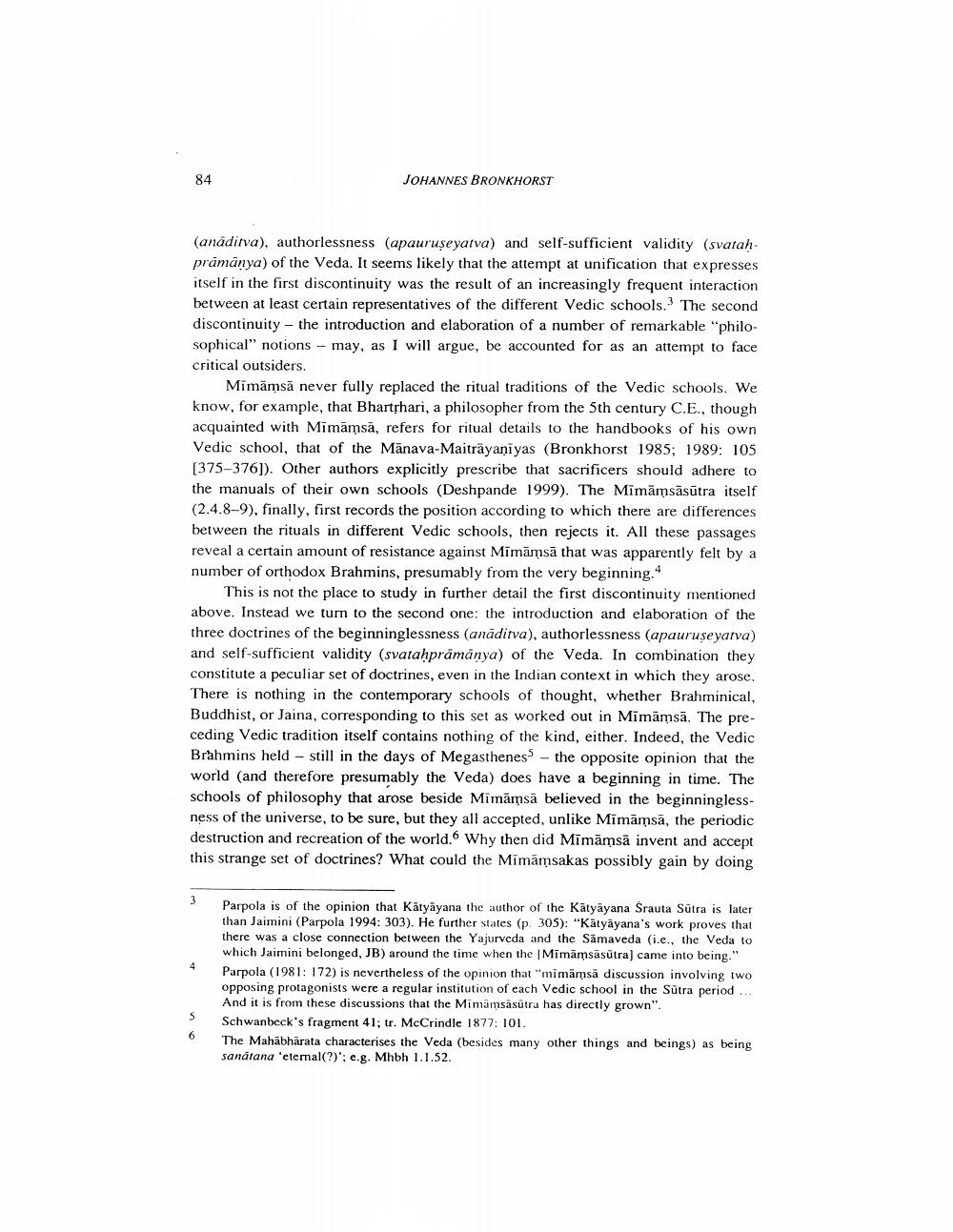Book Title: Origin Of Mimamsa As A School Of Thought A Hypothesis Author(s): Johannes Bronkhorst Publisher: Johannes Bronkhorst View full book textPage 2
________________ JOHANNES BRONKHORST (anádiva), authorlessness (apauruseyarva) and self-sufficient validity (svatahpramanya) of the Veda. It seems likely that the attempt at unification that expresses itself in the first discontinuity was the result of an increasingly frequent interaction between at least certain representatives of the different Vedic schools. The second discontinuity - the introduction and elaboration of a number of remarkable "philosophical” notions - may, as I will argue, be accounted for as an attempt to face Critical outsiders. Mimāmsā never fully replaced the ritual traditions of the Vedic schools. We know, for example, that Bharthari, a philosopher from the 5th century C.E., though acquainted with Mimāmsā, refers for ritual details to the handbooks of his own Vedic school, that of the Mänava-Maitrāyaniyas (Bronkhorst 1985; 1989: 105 (375-376)). Other authors explicitly prescribe that sacrificers should adhere to the manuals of their own schools (Deshpande 1999). The Mimāmsāsūtra itself (2.4.8-9), finally, first records the position according to which there are differences between the rituals in different Vedic schools, then rejects it. All these passages reveal a certain amount of resistance against Mimāms, that was apparently felt by a number of orthodox Brahmins, presumably from the very beginning." This is not the place to study in further detail the first discontinuity mentioned above. Instead we turn to the second one: the introduction and elaboration of the three doctrines of the beginninglessness (anāditva), authorlessness (apauruseyatva) and self-sufficient validity (svatahprāmánya) of the Veda. In combination they constitute a peculiar set of doctrines, even in the Indian context in which they arose. There is nothing in the contemporary schools of thought, whether Brahminical, Buddhist, or Jaina, corresponding to this set as worked out in Mimāmsā. The preceding Vedic tradition itself contains nothing of the kind, either. Indeed, the Vedic Brahmins held - still in the days of Megasthenes. - the opposite opinion that the world (and therefore presumably the Veda) does have a beginning in time. The schools of philosophy that arose beside Mimämsä believed in the beginninglessness of the universe, to be sure, but they all accepted, unlike Mimāmsā, the periodic destruction and recreation of the world. Why then did Mimämsä invent and accept this strange set of doctrines? What could the Mimāmsakas possibly gain by doing Parpola is of the opinion that Kätyāyana the author of the Katyayana Srauta Sutra is later than Jaimini (Parpola 1994: 303). He further states (p. 305): "Kätyāyana's work proves that there was a close connection between the Yajurveda and the Sämaveda (i.e., the Veda to which Jaimini belonged, JB) around the time when the Mimamsasutra) came into being." Parpola (1981: 172) is nevertheless of the opinion that "mimamsă discussion involving two opposing protagonists were a regular institution of each Vedic school in the Sutra period.. And it is from these discussions that the Mimamsasutra has directly grown". Schwanbeck's fragment 41; tr. McCrindle 1877: 101. The Mahābhārata characterises the Veda (besides many other things and beings) as being sanātana 'etemal(?)'; e.g. Mhbh 1.1.52.Page Navigation
1 2 3 4 5 6 7 8 9 10 11 12 13 14 15 16 17 18 19 20 21
